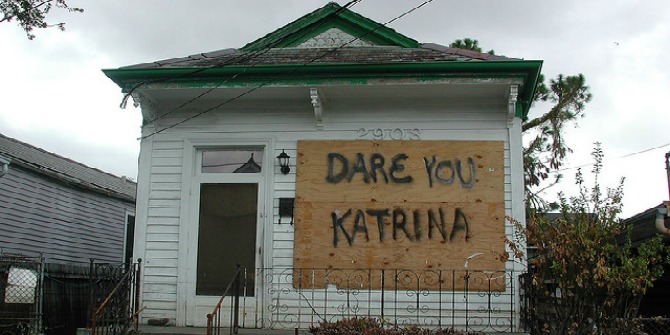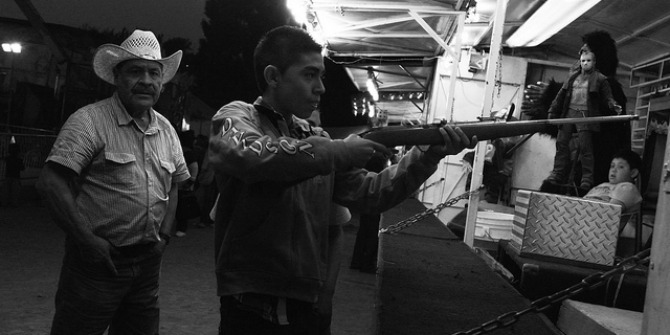The Inevitable City presents ten principles that ‘changed the game’ for New Orleans after Katrina, offered by community leader Scott Cowen, who was part of those leading the charge to restore equilibrium and eventually to rebuild. Elli Thomas finds that the book tells a fascinating story though the author’s tone is a little self-congratulatory at times.

Find this book:
Hurricane Katrina, when it hit New Orleans in 2005, killed 1,500 people, destroyed 200,000 homes, and forced 80% of the population out of the city. It threatened the future of a heartland, of music, soul, and community. Yet natural disaster followed years of economic decline and hardship, deep inequality, racial exclusion, and crime. Even before Katrina, New Orleans was the “homicide capital of the US”, with the astonishing homicide rate of 50 murders per 100,000 people. Poor schooling, inept policing, neglected public housing; these were a reality of life, and Katrina, rather than blowing them away in her path, only sank the city further into a valley of disorder.
In part, then, The Inevitable City is a story of New Orleans. The author, Scott Cowen, is the President of Tulane University and was one of individuals who led the rebuilding effort. The book is also something of an autobiography, as well as a manual on leadership. Each chapter addresses one of Cowen’s “leadership principles” – “do the right thing”, “marshal facts”, “understand reality”, “aim high” – each substantiated with anecdotes and details of the social and physical renewal effort of which Cowen was an integral part.
As a tale of urban renewal, The Inevitable City responds to an increasing awareness worldwide of the need for urban resilience in the face of natural disaster. The experiences of Christchurch, New Zealand, and of the Sendai region, Japan, illustrate the catastrophic effects of natural disasters on urban areas, and with climate change set to increase the threat of natural disaster on cities globally, a study such as this on effective and practical responses to these challenges has international interest. The approach taken by Cowen is resonant of KPMG’s recent report Magnet Cities: Decline, Fightback, Victory;both present decline and consequent renewal in simple, black and white terms, playing on notions of competition among cities that hinges upon their success and victory. It is convincing from a storytelling perspective, but it often obscures the complexity of New Orleans’ reality, which remains a city dogged by crime, poverty, and hardship, and is only at the beginning of a long period of social, economic, and physical rebuilding.
A key theme of The Inevitable City concerns how this success was achieved despite, not because of, the role of state and federal government. Chapter 6, “Fight, Fight, Fight”, concerns ethical leadership and “fierce battles over urban institutions”. The theme permeates the whole book and represents a kind of fierce individualism or pioneer spirit among those new leaders in New Orleans: Cowen, his colleagues at Tulane University, and a number of other individuals in the city, who were responsible for a series of grassroots initiatives to lower crime rates and improve healthcare, education, and housing in the city. The initiative of doctor Karen DeSalvo, in creating a number of community health centres, is described as a breakthrough in health services: “a case of the margin displacing the center”. Similarly, the Grow Dat Youth Farm, a youth development program offering social support and educational opportunities through agriculture, was introduced owing to a need to provide support that was underserved by official channels. Initiatives such as these demonstrate the social innovation that emerged to respond to the community’s needs after Katrina, comprising, as Cowen puts it, a “cultural change from a bureaucratic, top-down approach to the bottom-up activism of community leaders and civic institutions like Tulane”. The Federal Emergency Management Association, meanwhile, “couldn’t manage itself out of a paper bag”, and the anger of New Orleans residents towards the failure of other US cities and George W. Bush to respond effectively is emphasised. This theme, well-illustrated throughout the book and well explained as the triumph of grassroots initiatives, is unfortunately in part obscured by Cowen’s emphasis on leadership principles. The book may well have benefitted from a greater focus on it.

Social exclusion, which in New Orleans has strong racial overtones, also appears thematically throughout the book. Cowen describes the criminal activities of the New Orleans Police Department after Katrina – assaults, murders, and cover-ups – which were directed at black residents, and which left a sour taste of mistrust with the police and other state and city institutions. The epidemic of mistrust was one area that Cowen and other leaders sought to address through community engagement and outreach efforts. A deep mistrust also surrounded the fate of the Lower Ninth. A traditionally African American ward on the lower flood plains of New Orleans, and heavily flooded following Katrina, Mayor Ray Nagin proposed a repopulation plan which sought to rebuild on higher ground, and raze the Lower Ninth for green space. Cowen’s description of the discussions that followed are fascinating, and benefit greatly from his insider’s perspective; yet the Urban Planning report was not altered to rebuild the Lower Ninth. Cowen does discuss in some depth the other measures that were taken to repatriate the black community, but these passages seem one-sided in perspective, and I can’t help but wonder if there is a defensive element to Cowen’s description of the decisions made.
Resonating with the experience of the Heygate Estate in Southwark, which was recently sold for redevelopment despite local opposition, the fate of the New Orleans projects demonstrates the difficult decisions that the city had to make in redeveloping New Orleans. The projects, despite their community and significance, were demolished via a council vote, amidst desperate campaigns from the residents. Nevertheless, the need to rebuild the projects in accordance with a different social vision, of mixed communities led by public and private interests, demonstrate how – as Cowen puts it – “the time has come for a more integrated, organic vision that offers the poor a way into the mainstream”. Whether or not it does succeed in its inclusionary aims, it is nevertheless true – particularly in a UK context – that the limited capacity of the state means that the days of council-owned homes may be coming to an end. The ability of Cowen and his colleagues to make decisions on this front may contain useful lessons for council leaders on this side of the Atlantic, too.
There are moments in The Inevitable City, when Cowen steps out of his role as teacher and becomes more descriptive, when his writing is highly evocative: “a woman resplendent in white plumage with medallions of black beads, shaking her arms, tossing her braided hair, sings a rap, Celebration…resurrection…incarnation…Washington nation.” He also writes with real feeling about both the city’s devastation and its resurgence. However, where the book becomes more autobiographical, it becomes frustrating to read, and at times annoyingly self-congratulatory – especially for anyone who has a greater interest in New Orleans than Scott Cowen. The lessons on leadership at times verge on the preachy. There is no doubt of the contribution that Cowen made to the resurgence of New Orleans, but the author’s closeness to the events, and a confusion about the key purpose of the book, make me wonder if the book might have been better written by a third party. The conclusion of the book, which focuses back on Cowen and his principles of leadership, was glaring in its omission of any reflection of the ongoing challenges faced by New Orleans and its residents.
The Inevitable City is a nevertheless fascinating story that is competently, and at times eloquently written. It straddles (whether appropriately or not) a middle ground between leadership handbook and urban renewal studies that could appeal to both audiences. To the urbanist, it provides a practical and detailed overview of the plight and resurgence of New Orleans. To the aspiring city or business leader, it offers a set of principles which, although unfocused at times, can be constructive and are strengthened by being placed in context. Its downfall is that it seeks to be three things at once – a tale of urban renewal, leadership manual, and autobiography – all of which may well have been more successful as books in their own right.
This review originally appeared at the LSE Review of Books.
Please read our comments policy before commenting.
Note: This article gives the views of the authors, and not the position of USApp– American Politics and Policy, nor of the London School of Economics.
Shortened URL for this post: http://bit.ly/1vvysFj
——————————————–
Elli Thomas – Centre for Cities
Elli Thomas is a researcher at the Centre for Cities and a freelance urban designer and researcher. Her varied research interests collide around the economic, social and physical dimensions of exclusion and equality in cities. She completed an MA in Urban Design at the University of Westminster in 2014, and has previously worked for the National Trust. She also has a BA in History from the University of Oxford.





